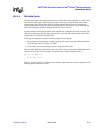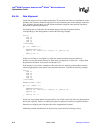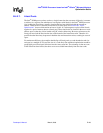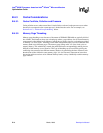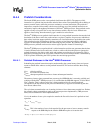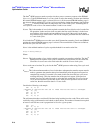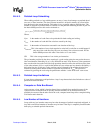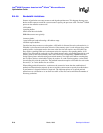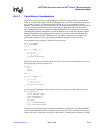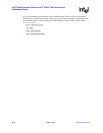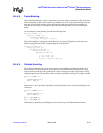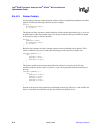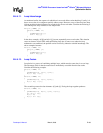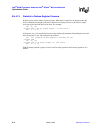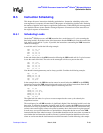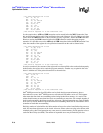
Developer’s Manual March, 2003 B-29
Intel
®
80200 Processor based on Intel
®
XScale
™
Microarchitecture
Optimization Guide
B.4.4.7. Cache Memory Considerations
Stride, the way data structures are walked through, can affect the temporal quality of the data and
reduce or increase cache conflicts. The Intel
®
80200 processor data cache and mini-data caches each
have 32 sets of 32 bytes. This means that each cache line in a set is on a modular 1K-address
boundary. The caution is to choose data structure sizes and stride requirements that do not overwhelm
a given set causing conflicts and increased register pressure. Register pressure can be increased
because additional registers are required to track prefetch addresses. The effects can be affected by
rearranging data structure components to use more parallel access to search and compare elements.
Similarly rearranging sections of data structures so that sections often written fit in the same half
cache line, 16 bytes for the Intel
®
80200 processor, can reduce cache eviction write-backs. On a
global scale, techniques such as array merging can enhance the spatial locality of the data.
As an example of array merging, consider the following code:
int a_array[NMAX];
int b_array[NMAX];
int ix;
for (i=0; i<NMAX]; i++)
{
ix = b[i];
if (a[i] != 0)
ix = a[i];
do_other calculations;
}
In the above code, data is read from both arrays a and b, but a and b are not spatially close. Array
merging can place a and b specially close.
struct {
int a;
int b;
} c_arrays;
int ix;
for (i=0; i<NMAX]; i++)
{
ix = c[i].b;
if (c[i].a != 0)
ix = c[i].a;
do_other_calculations;
}
As an example of rearranging often written to sections in a structure, consider the code sample:
struct employee {
struct employee *prev;
struct employee *next;
float Year2DatePay;
float Year2DateTax;
int ssno;
int empid;
float Year2Date401KDed;
float Year2DateOtherDed;
};
In the data structure shown above, the fields Year2DatePay, Year2DateTax, Year2Date401KDed,
and Year2DateOtherDed are likely to change with each pay check. The remaining fields however
change very rarely. If the fields are laid out as shown above, assuming that the structure is aligned



